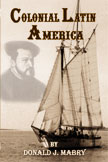Early Attempts to Organize an Empire (revised)
2001 Donald J. Mabry
The Crown first used adelantados (military officials) and some gobernadores
(governors). Spanish formed cabildos (town councils) which had jurisdiction not only over
urban areas but the surrounding countryside. The cabildo could appoint gobernadores and
corregidores.
The high court or audiencia was introduced into the New World at
Santo Domingo in 1511.
Crown faced the problem of dealing with ambitious men. Men on a
conquest believed that the Crown owed them titles and property for the sacrifices they had
made. Tremendous rivalry among them and between them and later officials.
In New Spain (Mexico), the first audiencia (1528-30) with Gonzalo
Nuño de Guzmán as president ruled with such cruelty and high-handedness (confiscating
some of the encomiendas that Cortés had distributed) that it aroused the wrath of
honest citizens and stirred the clergy led by Bishop Zumárraga. The bishop excommunicated
him and the audiencia in 1529. Not fazed by this, he explored Michoacán, Jalisco, and
Sinaloa. Although he ruled as a governor in western Mexico, the Crown finally learned of
his crimes, had him tried in Mexico City, and then shipped him to Spain. The second
audiencia (1530-35) was run by clergymen but they were unable to control Cortés
other than to forbid him from entering Mexico City. The conquistadores continued to engage
in disputes with royal authorities and each other. The Crown sent Antonio de Mendoza to
New Spain as the first viceroy. For the next fifteen years, Mendoza, a member of one of
the great Spanish families, brought peace, order, and regularity to the viceroyalty.
In Peru, the early days of the empire were much more problematic for
the conquistadores engaged in civil war. Throughout the 1530s and 1540s, the Pizarro and
Almagro factions cut each other up. The crown sent Mendoza to Peru in 1551 but he died
with a year. Although the audiencia made progress in establishing royal authority, it was
Viceroy Francisco Toledo who served from 1569-1581 who consolidated royal authority and
Spanish dominance in the viceroyalty. He was the author of the colonial system in Peru,
much of which was used elsewhere in the Spanish colonies.
You can read about other topics in colonial Latin American history by buying and reading
 Colonial Latin America by Don Mabry.
Colonial Latin America by Don Mabry.
Click on the book cover or the title to go to Llumina Press.

